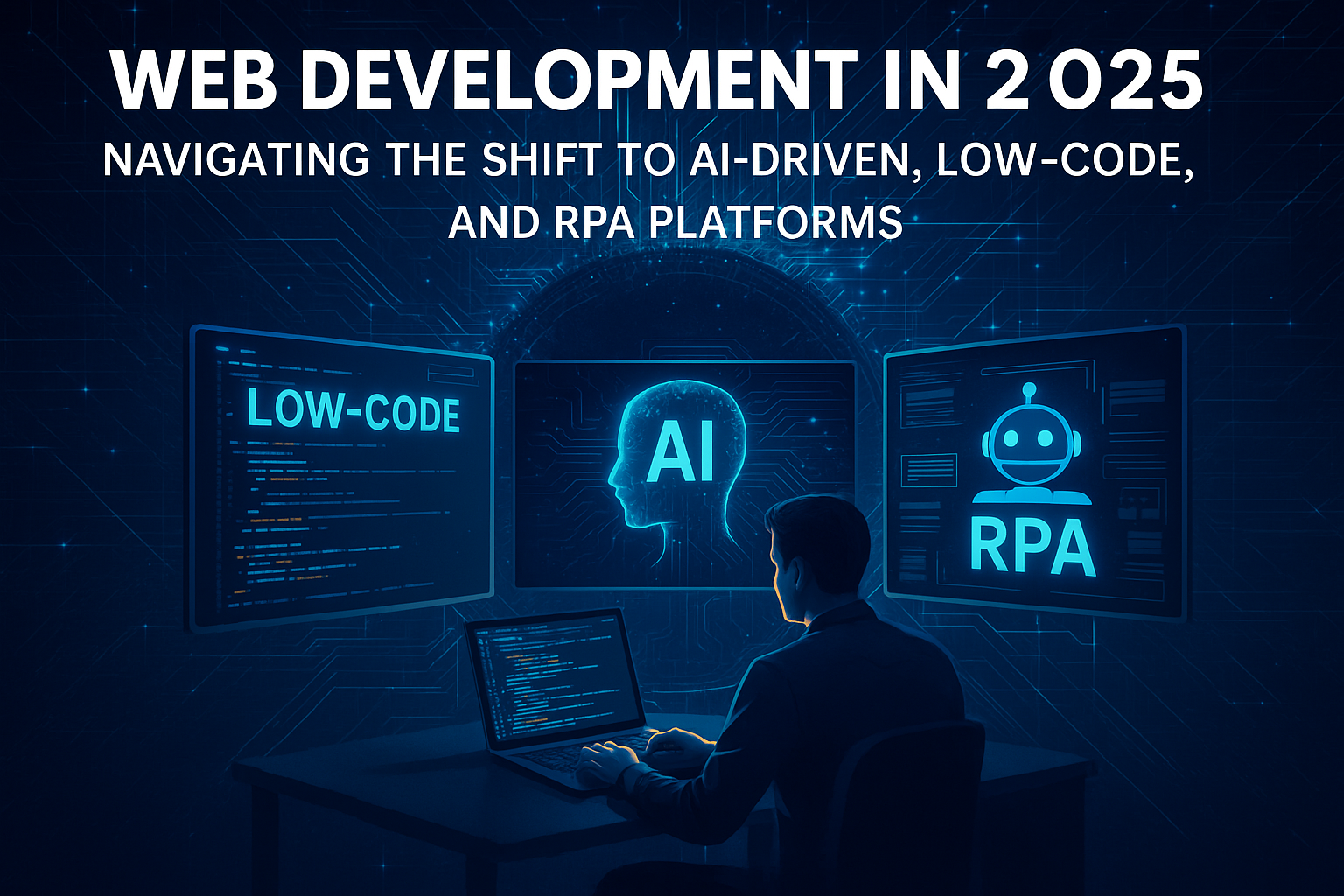Web Development in 2025: A Quick Guide to AI, Low-Code, and RPA
Technology
Web Development in 2025: Navigating the Shift to AI-Driven, Low-Code, and RPA Platforms
Picture this: it’s 2025, and I’m sitting at my desk, sipping coffee, ready to build a sleek e-commerce site for a client. I’d fire up VS Code, spin up a React project, and spent hours wrestling with CSS grid. But today? I’m tweaking a site generated by an AI-powered builder in minutes, using tools like Framer AI to auto-generate responsive layouts, then handing it off to a low-code platform like Bubble for the client to customize with drag-and-drop ease. The game has changed dramatically, blending traditional coding with AI automation and low-code workflows. As developers, we’re racing to adapt to this new era. Welcome to web development in 2025—a world where AI and low-code platforms are rewriting the rules, and we’re all finding our place in this fast-evolving landscape.
My Wake-Up Call
Last year, I hit pause on blogging to ride the tech wave—and wow, AI didn’t just stir the pot, it flipped the whole table. I figured my full stack arsenal—React, Node.js, Spring Boot, Vue.js, Laravel, Django, Tailwind, and trusty databases like PostgreSQL and MongoDB—had me covered. Then a friend built a working prototype in hours using Bubble. I was shook.
Next thing I knew, tools like Framer AI and Wix ADI were designing faster than I could even say npm install. Meanwhile, serverless heroes like AWS Lambda, Vercel, and Netlify made scaling feel like magic. Old-school AWS tools (hello EC2 and Elastic Beanstalk) still held their ground, and juggling SQL (MySQL) and NoSQL (DynamoDB) was smoother than ever.
But the wildest part? AI-generated images. This blog’s header? Done in seconds by Grok. Bold, futuristic, and totally on-theme with AI, low-code, and RPA.
Bottom line: web dev in 2025 is fast, fearless, and fully transformed. It’s not the future—it’s right now. Let’s dive in.
The Big Shift: AI, Low-Code, and RPA Take Over
AI-Driven Development: Your Code-Writing Sidekick
AI isn’t just for memes anymore—it’s building websites. Tools like Framer AI or Wix’s ADI churn out responsive layouts, suggest content, and optimize SEO from a single prompt. Type “sleek SaaS landing page, green palette, with a signup form,” and you’ve got a prototype in minutes. Frameworks like Next.js 15 are leaning in, with AI-assisted plugins that suggest optimized components or debug code. These tools are fast, but they need a human touch for custom logic or tricky integrations.
Low-Code Platforms: Everyone’s a Developer
Low-code platforms like Bubble, Webflow, and ProcessMaker let anyone build apps with visual editors. I saw a startup launch an MVP in a weekend using Bubble—no server setup, no database migraines. ProcessMaker takes it further, blending low-code with process automation to streamline workflows like form submissions or approvals. Newgen’s platform is another heavy hitter, enabling rapid app development with built-in automation for enterprise needs. The catch? Low-code can trap you in its ecosystem, and performance can suffer without careful optimization.
RPA and Process Automation: The Workflow Wizards
Robotic Process Automation (RPA) is the unsung hero of 2025. Tools like UiPath and Microsoft Power Automate automate repetitive tasks—think syncing data between a website and a CRM or processing user uploads. I recently saw a dev use Power Automate to connect a Webflow site to a client’s inventory system, no custom backend required. API/SOA integration tools like TIBCO amplify this, enabling seamless connections between legacy systems and modern web apps. RPA and integration tools save time but demand we understand workflows and APIs deeply to avoid brittle setups.
Opportunities and Challenges for Developers
What does this mean for us? Let’s break it down.
The Good
- Speed and Scale: AI generates designs, low-code handles frontends, and RPA automates workflows. A solo dev can deliver enterprise-grade apps by combining Framer, Bubble, and UiPath, with serverless hosting like AWS Lambda or Vercel handling the backend, SQL/NoSQL options like MySQL or DynamoDB managing data, and Grok creating stunning visuals.
- New Roles: We’re not just coders—we’re consultants guiding clients through Newgen or TIBCO, or specialists building custom integrations for ProcessMaker, all deployable on AWS-managed or serverless platforms.
- Automation Edge: RPA tools like Power Automate let us offer clients slick, automated workflows, while AWS server management tools and serverless options eliminate server management overhead.
- Easier Experimentation: Next.js 15’s AI helpers and low-code platforms lower the barrier to trying new features, with serverless options like Netlify Functions and Spring Boot microservices speeding up deployment.
The Not-So-Good
- Skill Gaps: Junior devs might struggle as businesses use low-code and RPA for simple projects. We need to master automation, integration, serverless architectures, Spring Boot, SQL/NoSQL databases, and AI to stay relevant.
- Tool Overload: Bubble, Webflow, ProcessMaker, UiPath, TIBCO, Newgen, AWS Lambda, Vercel, EC2, Elastic Beanstalk, MySQL, DynamoDB, Grok—the list is endless. Choosing what to learn is overwhelming.
- Loss of Control: AI code can be messy, low-code platforms limit customization, and RPA setups can break if APIs change unexpectedly. Serverless can introduce cold start delays, and AWS management requires careful configuration.
Summary
Web development in 2025 is a thrilling evolution, driven by AI-powered tools, low-code platforms, and RPA, with serverless hosting, Spring Boot, SQL/NoSQL databases, and AI-generated content like this blog’s header accelerating the pace. While these innovations offer unprecedented speed and scalability—enabling solo developers to rival large teams with tools like Framer, Bubble, and UiPath—they also bring challenges, including skill gaps, tool overload, and potential loss of control. By embracing AI as a co-pilot, mastering select platforms, exploring serverless and AWS management, leveraging Spring Boot with MySQL or DynamoDB, and experimenting with image generation, developers can thrive in this dynamic landscape. The future is here, and it’s up to us to shape it with creativity and adaptability.
Web Development in 2025: Navigating the Shift to AI-Driven, Low-Code, and RPA Platforms
Picture this: it’s 2025, and I’m sitting at my desk, sipping coffee, ready to build a sleek e-commerce site for a client. I’d fire up VS Code, spin up a React project, and spend hours wrestling with CSS grid. But today? I’m tweaking a site generated by an AI-powered builder in minutes, using tools like Framer AI to auto-generate responsive layouts, then handing it off to a low-code platform like Bubble for the client to customize with drag-and-drop ease. The game has changed dramatically, blending traditional coding with AI automation and low-code workflows. As developers, we’re racing to adapt to this new era. Welcome to web development in 2025—a world where AI and low-code platforms are rewriting the rules, and we’re all finding our place in this fast-evolving landscape.
My Wake-Up Call
Last year, I hit pause on blogging to ride the tech wave—and wow, AI didn’t just stir the pot, it flipped the whole table. I figured my full stack arsenal—React, Node.js, Spring Boot, Vue.js, Laravel, Django, Tailwind, and trusty databases like PostgreSQL and MongoDB—had me covered. Then a friend built a working prototype in hours using Bubble. I was shook.
Next thing I knew, tools like Framer AI and Wix ADI were designing faster than I could even say npm install. Meanwhile, serverless heroes like AWS Lambda, Vercel, and Netlify made scaling feel like magic. Old-school AWS tools (hello EC2 and Elastic Beanstalk) still held their ground, and juggling SQL (MySQL) and NoSQL (DynamoDB) was smoother than ever.
But the wildest part? AI-generated images. This blog’s header? Done in seconds by Grok. Bold, futuristic, and totally on-theme with AI, low-code, and RPA.
Bottom line: web dev in 2025 is fast, fearless, and fully transformed. It’s not the future—it’s right now. Let’s dive in.
The Big Shift: AI, Low-Code, and RPA Take Over
AI-Driven Development: Your Code-Writing Sidekick
AI isn’t just for memes anymore—it’s building websites. Tools like Framer AI or Wix’s ADI churn out responsive layouts, suggest content, and optimize SEO from a single prompt. Type “sleek SaaS landing page, green palette, with a signup form,” and you’ve got a prototype in minutes. Frameworks like Next.js 15 are leaning in, with AI-assisted plugins that suggest optimized components or debug code. These tools are fast, but they need a human touch for custom logic or tricky integrations.
Low-Code Platforms: Everyone’s a Developer
Low-code platforms like Bubble, Webflow, and ProcessMaker let anyone build apps with visual editors. I saw a startup launch an MVP in a weekend using Bubble—no server setup, no database migraines. ProcessMaker takes it further, blending low-code with process automation to streamline workflows like form submissions or approvals. Newgen’s platform is another heavy hitter, enabling rapid app development with built-in automation for enterprise needs. The catch? Low-code can trap you in its ecosystem, and performance can suffer without careful optimization.
RPA and Process Automation: The Workflow Wizards
Robotic Process Automation (RPA) is the unsung hero of 2025. Tools like UiPath and Microsoft Power Automate automate repetitive tasks—think syncing data between a website and a CRM or processing user uploads. I recently saw a dev use Power Automate to connect a Webflow site to a client’s inventory system, no custom backend required. API/SOA integration tools like TIBCO amplify this, enabling seamless connections between legacy systems and modern web apps. RPA and integration tools save time but demand we understand workflows and APIs deeply to avoid brittle setups.
Opportunities and Challenges for Developers
What does this mean for us? Let’s break it down.
The Good
Speed and Scale: AI generates designs, low-code handles frontends, and RPA automates workflows. A solo dev can deliver enterprise-grade apps by combining Framer, Bubble, and UiPath, with serverless hosting like AWS Lambda or Vercel handling the backend, SQL/NoSQL options like MySQL or DynamoDB managing data, and Grok creating stunning visuals.
New Roles: We’re not just coders—we’re consultants guiding clients through Newgen or TIBCO, or specialists building custom integrations for ProcessMaker, all deployable on AWS-managed or serverless platforms.
Automation Edge: RPA tools like Power Automate let us offer clients slick, automated workflows, while AWS server management tools and serverless options eliminate server management overhead.
Easier Experimentation: Next.js 15’s AI helpers and low-code platforms lower the barrier to trying new features, with serverless options like Netlify Functions and Spring Boot microservices speeding up deployment.
The Not-So-Good
Skill Gaps: Junior devs might struggle as businesses use low-code and RPA for simple projects. We need to master automation, integration, serverless architectures, Spring Boot, SQL/NoSQL databases, and AI to stay relevant.
Tool Overload: Bubble, Webflow, ProcessMaker, UiPath, TIBCO, Newgen, AWS Lambda, Vercel, EC2, Elastic Beanstalk, MySQL, DynamoDB, Grok—the list is endless. Choosing what to learn is overwhelming.
Loss of Control: AI code can be messy, low-code platforms limit customization, and RPA setups can break if APIs change unexpectedly. Serverless can introduce cold start delays, and AWS management requires careful configuration.
Summary
Web development in 2025 is a thrilling evolution, driven by AI-powered tools, low-code platforms, and RPA, with serverless hosting, Spring Boot, SQL/NoSQL databases, and AI-generated content like this blog’s header accelerating the pace. While these innovations offer unprecedented speed and scalability—enabling solo developers to rival large teams with tools like Framer, Bubble, and UiPath—they also bring challenges, including skill gaps, tool overload, and potential loss of control. By embracing AI as a co-pilot, mastering select platforms, exploring serverless and AWS management, leveraging Spring Boot with MySQL or DynamoDB, and experimenting with image generation, developers can thrive in this dynamic landscape. The future is here, and it’s up to us to shape it with creativity and adaptability.
Web Development in 2025: A Quick Guide to AI, Low-Code, and RPA
 "Artificial intelligence is not a substitute for human intelligence; it is a tool to amplify human creativity and capability." — Fei-Fei Li, Co-Director of the Stanford Institute for Human-Centered AI
"Artificial intelligence is not a substitute for human intelligence; it is a tool to amplify human creativity and capability." — Fei-Fei Li, Co-Director of the Stanford Institute for Human-Centered AI
May 05, 2025

